Assignment on Septic Shock PDF
VerifiedAdded on 2021/02/19
|9
|2601
|36
AI Summary
Contribute Materials
Your contribution can guide someone’s learning journey. Share your
documents today.

Septic Shock
Secure Best Marks with AI Grader
Need help grading? Try our AI Grader for instant feedback on your assignments.
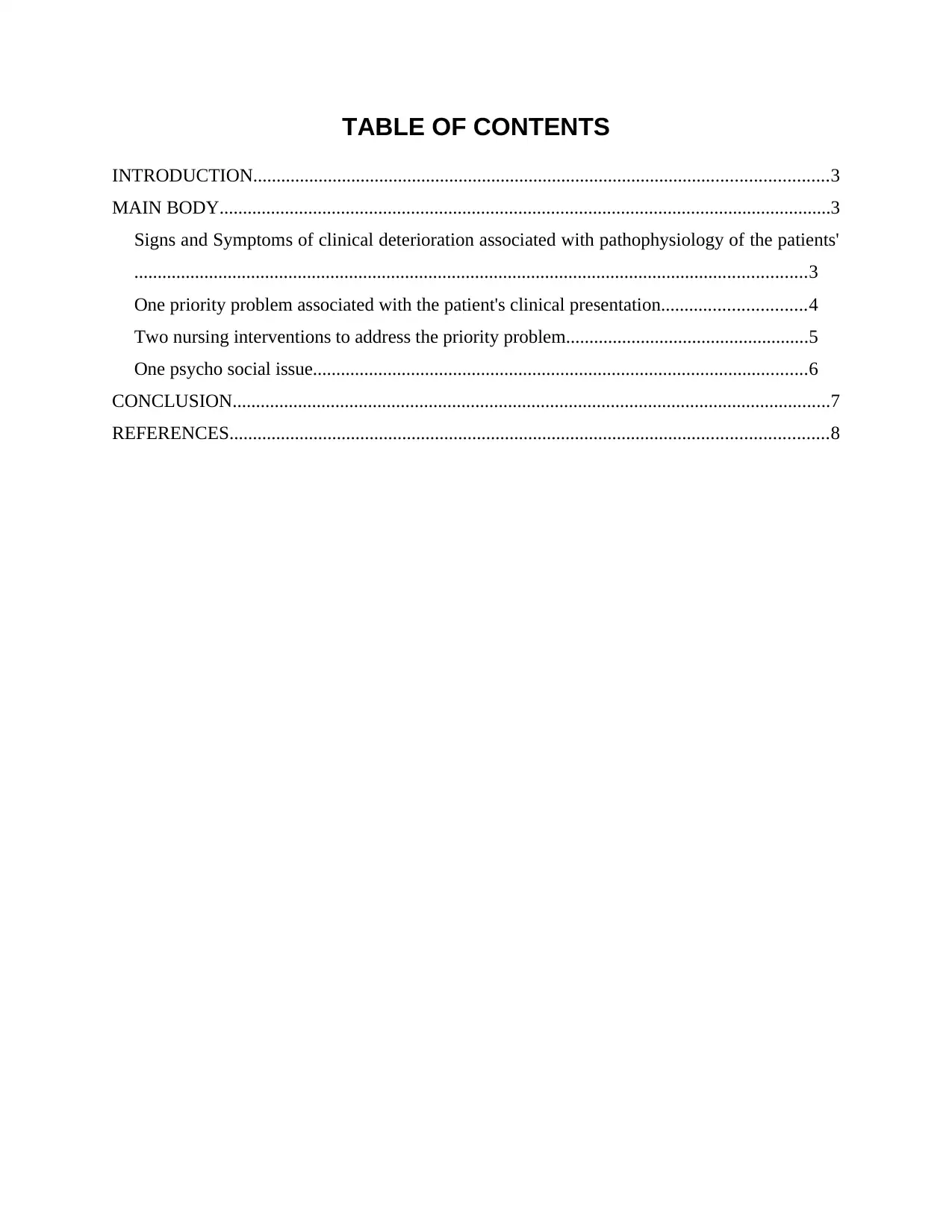
TABLE OF CONTENTS
INTRODUCTION...........................................................................................................................3
MAIN BODY...................................................................................................................................3
Signs and Symptoms of clinical deterioration associated with pathophysiology of the patients'
................................................................................................................................................3
One priority problem associated with the patient's clinical presentation...............................4
Two nursing interventions to address the priority problem....................................................5
One psycho social issue..........................................................................................................6
CONCLUSION................................................................................................................................7
REFERENCES................................................................................................................................8
INTRODUCTION...........................................................................................................................3
MAIN BODY...................................................................................................................................3
Signs and Symptoms of clinical deterioration associated with pathophysiology of the patients'
................................................................................................................................................3
One priority problem associated with the patient's clinical presentation...............................4
Two nursing interventions to address the priority problem....................................................5
One psycho social issue..........................................................................................................6
CONCLUSION................................................................................................................................7
REFERENCES................................................................................................................................8
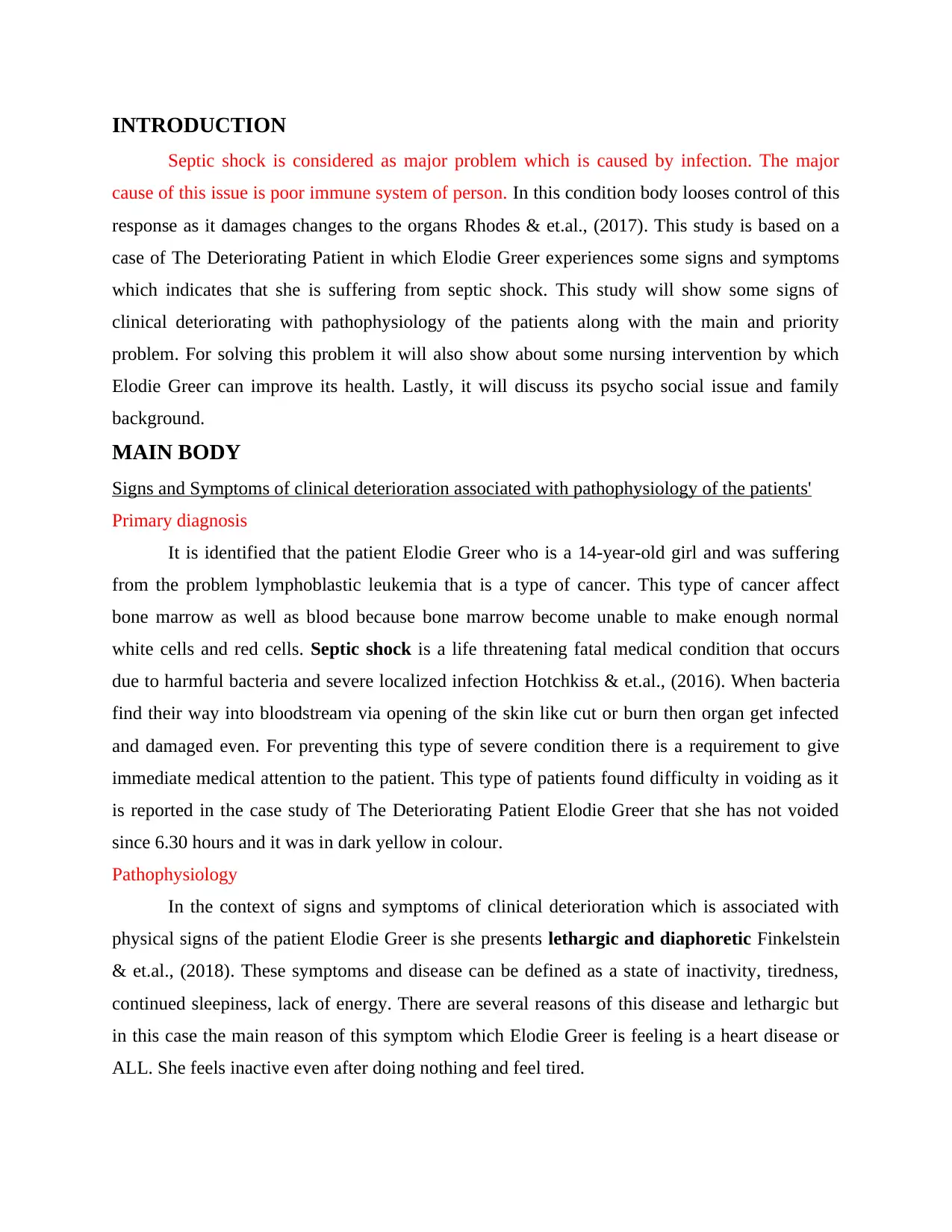
INTRODUCTION
Septic shock is considered as major problem which is caused by infection. The major
cause of this issue is poor immune system of person. In this condition body looses control of this
response as it damages changes to the organs Rhodes & et.al., (2017). This study is based on a
case of The Deteriorating Patient in which Elodie Greer experiences some signs and symptoms
which indicates that she is suffering from septic shock. This study will show some signs of
clinical deteriorating with pathophysiology of the patients along with the main and priority
problem. For solving this problem it will also show about some nursing intervention by which
Elodie Greer can improve its health. Lastly, it will discuss its psycho social issue and family
background.
MAIN BODY
Signs and Symptoms of clinical deterioration associated with pathophysiology of the patients'
Primary diagnosis
It is identified that the patient Elodie Greer who is a 14-year-old girl and was suffering
from the problem lymphoblastic leukemia that is a type of cancer. This type of cancer affect
bone marrow as well as blood because bone marrow become unable to make enough normal
white cells and red cells. Septic shock is a life threatening fatal medical condition that occurs
due to harmful bacteria and severe localized infection Hotchkiss & et.al., (2016). When bacteria
find their way into bloodstream via opening of the skin like cut or burn then organ get infected
and damaged even. For preventing this type of severe condition there is a requirement to give
immediate medical attention to the patient. This type of patients found difficulty in voiding as it
is reported in the case study of The Deteriorating Patient Elodie Greer that she has not voided
since 6.30 hours and it was in dark yellow in colour.
Pathophysiology
In the context of signs and symptoms of clinical deterioration which is associated with
physical signs of the patient Elodie Greer is she presents lethargic and diaphoretic Finkelstein
& et.al., (2018). These symptoms and disease can be defined as a state of inactivity, tiredness,
continued sleepiness, lack of energy. There are several reasons of this disease and lethargic but
in this case the main reason of this symptom which Elodie Greer is feeling is a heart disease or
ALL. She feels inactive even after doing nothing and feel tired.
Septic shock is considered as major problem which is caused by infection. The major
cause of this issue is poor immune system of person. In this condition body looses control of this
response as it damages changes to the organs Rhodes & et.al., (2017). This study is based on a
case of The Deteriorating Patient in which Elodie Greer experiences some signs and symptoms
which indicates that she is suffering from septic shock. This study will show some signs of
clinical deteriorating with pathophysiology of the patients along with the main and priority
problem. For solving this problem it will also show about some nursing intervention by which
Elodie Greer can improve its health. Lastly, it will discuss its psycho social issue and family
background.
MAIN BODY
Signs and Symptoms of clinical deterioration associated with pathophysiology of the patients'
Primary diagnosis
It is identified that the patient Elodie Greer who is a 14-year-old girl and was suffering
from the problem lymphoblastic leukemia that is a type of cancer. This type of cancer affect
bone marrow as well as blood because bone marrow become unable to make enough normal
white cells and red cells. Septic shock is a life threatening fatal medical condition that occurs
due to harmful bacteria and severe localized infection Hotchkiss & et.al., (2016). When bacteria
find their way into bloodstream via opening of the skin like cut or burn then organ get infected
and damaged even. For preventing this type of severe condition there is a requirement to give
immediate medical attention to the patient. This type of patients found difficulty in voiding as it
is reported in the case study of The Deteriorating Patient Elodie Greer that she has not voided
since 6.30 hours and it was in dark yellow in colour.
Pathophysiology
In the context of signs and symptoms of clinical deterioration which is associated with
physical signs of the patient Elodie Greer is she presents lethargic and diaphoretic Finkelstein
& et.al., (2018). These symptoms and disease can be defined as a state of inactivity, tiredness,
continued sleepiness, lack of energy. There are several reasons of this disease and lethargic but
in this case the main reason of this symptom which Elodie Greer is feeling is a heart disease or
ALL. She feels inactive even after doing nothing and feel tired.
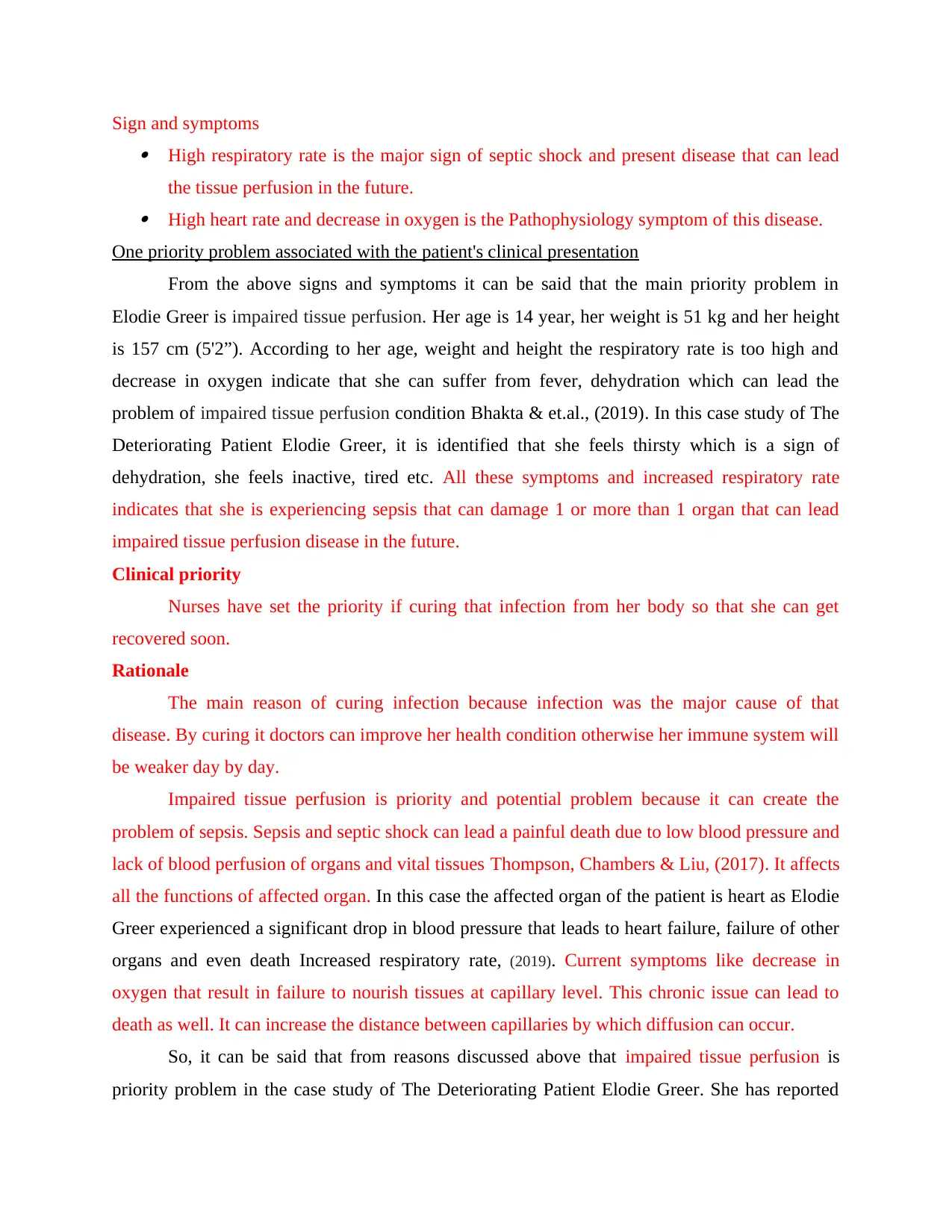
Sign and symptoms High respiratory rate is the major sign of septic shock and present disease that can lead
the tissue perfusion in the future. High heart rate and decrease in oxygen is the Pathophysiology symptom of this disease.
One priority problem associated with the patient's clinical presentation
From the above signs and symptoms it can be said that the main priority problem in
Elodie Greer is impaired tissue perfusion. Her age is 14 year, her weight is 51 kg and her height
is 157 cm (5'2”). According to her age, weight and height the respiratory rate is too high and
decrease in oxygen indicate that she can suffer from fever, dehydration which can lead the
problem of impaired tissue perfusion condition Bhakta & et.al., (2019). In this case study of The
Deteriorating Patient Elodie Greer, it is identified that she feels thirsty which is a sign of
dehydration, she feels inactive, tired etc. All these symptoms and increased respiratory rate
indicates that she is experiencing sepsis that can damage 1 or more than 1 organ that can lead
impaired tissue perfusion disease in the future.
Clinical priority
Nurses have set the priority if curing that infection from her body so that she can get
recovered soon.
Rationale
The main reason of curing infection because infection was the major cause of that
disease. By curing it doctors can improve her health condition otherwise her immune system will
be weaker day by day.
Impaired tissue perfusion is priority and potential problem because it can create the
problem of sepsis. Sepsis and septic shock can lead a painful death due to low blood pressure and
lack of blood perfusion of organs and vital tissues Thompson, Chambers & Liu, (2017). It affects
all the functions of affected organ. In this case the affected organ of the patient is heart as Elodie
Greer experienced a significant drop in blood pressure that leads to heart failure, failure of other
organs and even death Increased respiratory rate, (2019). Current symptoms like decrease in
oxygen that result in failure to nourish tissues at capillary level. This chronic issue can lead to
death as well. It can increase the distance between capillaries by which diffusion can occur.
So, it can be said that from reasons discussed above that impaired tissue perfusion is
priority problem in the case study of The Deteriorating Patient Elodie Greer. She has reported
the tissue perfusion in the future. High heart rate and decrease in oxygen is the Pathophysiology symptom of this disease.
One priority problem associated with the patient's clinical presentation
From the above signs and symptoms it can be said that the main priority problem in
Elodie Greer is impaired tissue perfusion. Her age is 14 year, her weight is 51 kg and her height
is 157 cm (5'2”). According to her age, weight and height the respiratory rate is too high and
decrease in oxygen indicate that she can suffer from fever, dehydration which can lead the
problem of impaired tissue perfusion condition Bhakta & et.al., (2019). In this case study of The
Deteriorating Patient Elodie Greer, it is identified that she feels thirsty which is a sign of
dehydration, she feels inactive, tired etc. All these symptoms and increased respiratory rate
indicates that she is experiencing sepsis that can damage 1 or more than 1 organ that can lead
impaired tissue perfusion disease in the future.
Clinical priority
Nurses have set the priority if curing that infection from her body so that she can get
recovered soon.
Rationale
The main reason of curing infection because infection was the major cause of that
disease. By curing it doctors can improve her health condition otherwise her immune system will
be weaker day by day.
Impaired tissue perfusion is priority and potential problem because it can create the
problem of sepsis. Sepsis and septic shock can lead a painful death due to low blood pressure and
lack of blood perfusion of organs and vital tissues Thompson, Chambers & Liu, (2017). It affects
all the functions of affected organ. In this case the affected organ of the patient is heart as Elodie
Greer experienced a significant drop in blood pressure that leads to heart failure, failure of other
organs and even death Increased respiratory rate, (2019). Current symptoms like decrease in
oxygen that result in failure to nourish tissues at capillary level. This chronic issue can lead to
death as well. It can increase the distance between capillaries by which diffusion can occur.
So, it can be said that from reasons discussed above that impaired tissue perfusion is
priority problem in the case study of The Deteriorating Patient Elodie Greer. She has reported
Secure Best Marks with AI Grader
Need help grading? Try our AI Grader for instant feedback on your assignments.
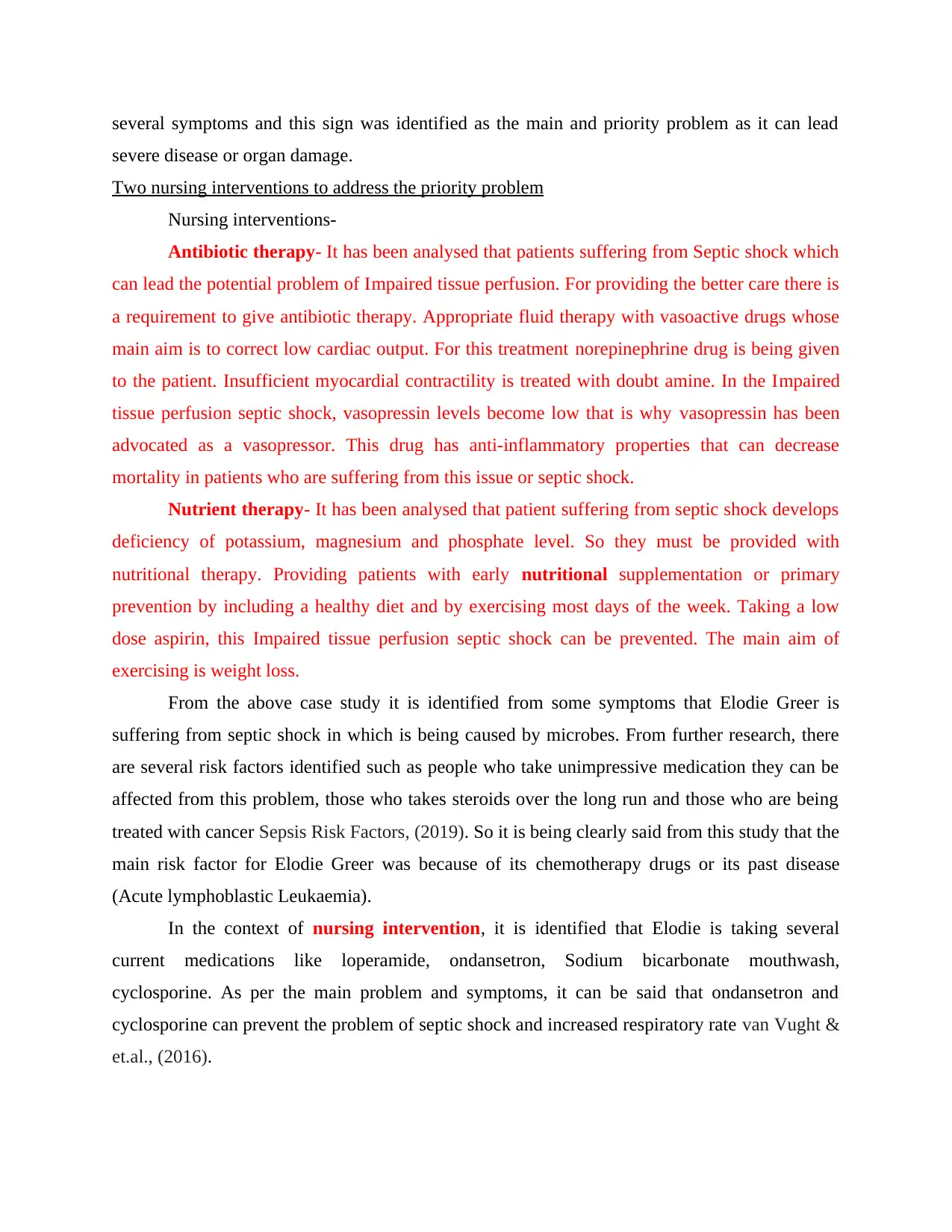
several symptoms and this sign was identified as the main and priority problem as it can lead
severe disease or organ damage.
Two nursing interventions to address the priority problem
Nursing interventions-
Antibiotic therapy- It has been analysed that patients suffering from Septic shock which
can lead the potential problem of Impaired tissue perfusion. For providing the better care there is
a requirement to give antibiotic therapy. Appropriate fluid therapy with vasoactive drugs whose
main aim is to correct low cardiac output. For this treatment norepinephrine drug is being given
to the patient. Insufficient myocardial contractility is treated with doubt amine. In the Impaired
tissue perfusion septic shock, vasopressin levels become low that is why vasopressin has been
advocated as a vasopressor. This drug has anti-inflammatory properties that can decrease
mortality in patients who are suffering from this issue or septic shock.
Nutrient therapy- It has been analysed that patient suffering from septic shock develops
deficiency of potassium, magnesium and phosphate level. So they must be provided with
nutritional therapy. Providing patients with early nutritional supplementation or primary
prevention by including a healthy diet and by exercising most days of the week. Taking a low
dose aspirin, this Impaired tissue perfusion septic shock can be prevented. The main aim of
exercising is weight loss.
From the above case study it is identified from some symptoms that Elodie Greer is
suffering from septic shock in which is being caused by microbes. From further research, there
are several risk factors identified such as people who take unimpressive medication they can be
affected from this problem, those who takes steroids over the long run and those who are being
treated with cancer Sepsis Risk Factors, (2019). So it is being clearly said from this study that the
main risk factor for Elodie Greer was because of its chemotherapy drugs or its past disease
(Acute lymphoblastic Leukaemia).
In the context of nursing intervention, it is identified that Elodie is taking several
current medications like loperamide, ondansetron, Sodium bicarbonate mouthwash,
cyclosporine. As per the main problem and symptoms, it can be said that ondansetron and
cyclosporine can prevent the problem of septic shock and increased respiratory rate van Vught &
et.al., (2016).
severe disease or organ damage.
Two nursing interventions to address the priority problem
Nursing interventions-
Antibiotic therapy- It has been analysed that patients suffering from Septic shock which
can lead the potential problem of Impaired tissue perfusion. For providing the better care there is
a requirement to give antibiotic therapy. Appropriate fluid therapy with vasoactive drugs whose
main aim is to correct low cardiac output. For this treatment norepinephrine drug is being given
to the patient. Insufficient myocardial contractility is treated with doubt amine. In the Impaired
tissue perfusion septic shock, vasopressin levels become low that is why vasopressin has been
advocated as a vasopressor. This drug has anti-inflammatory properties that can decrease
mortality in patients who are suffering from this issue or septic shock.
Nutrient therapy- It has been analysed that patient suffering from septic shock develops
deficiency of potassium, magnesium and phosphate level. So they must be provided with
nutritional therapy. Providing patients with early nutritional supplementation or primary
prevention by including a healthy diet and by exercising most days of the week. Taking a low
dose aspirin, this Impaired tissue perfusion septic shock can be prevented. The main aim of
exercising is weight loss.
From the above case study it is identified from some symptoms that Elodie Greer is
suffering from septic shock in which is being caused by microbes. From further research, there
are several risk factors identified such as people who take unimpressive medication they can be
affected from this problem, those who takes steroids over the long run and those who are being
treated with cancer Sepsis Risk Factors, (2019). So it is being clearly said from this study that the
main risk factor for Elodie Greer was because of its chemotherapy drugs or its past disease
(Acute lymphoblastic Leukaemia).
In the context of nursing intervention, it is identified that Elodie is taking several
current medications like loperamide, ondansetron, Sodium bicarbonate mouthwash,
cyclosporine. As per the main problem and symptoms, it can be said that ondansetron and
cyclosporine can prevent the problem of septic shock and increased respiratory rate van Vught &
et.al., (2016).
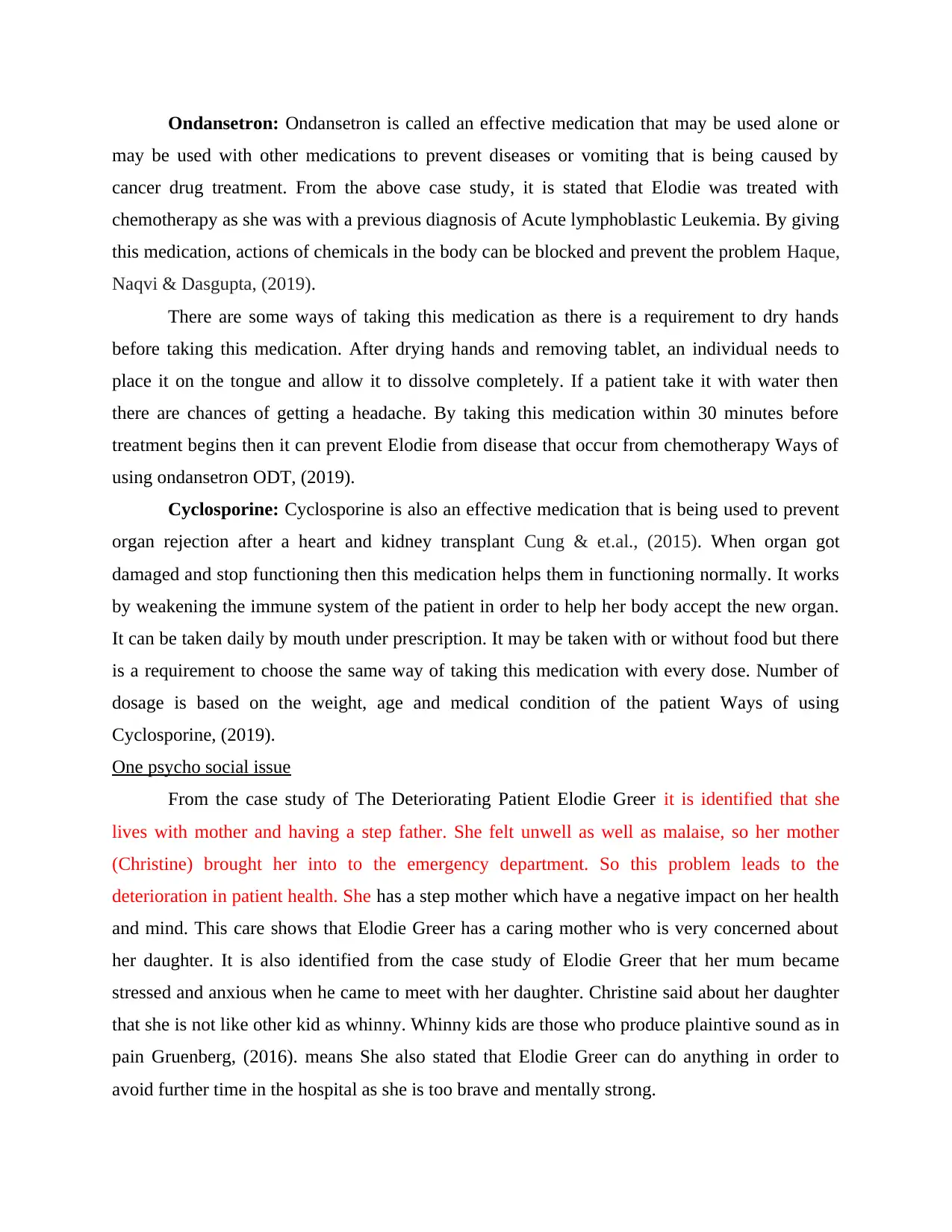
Ondansetron: Ondansetron is called an effective medication that may be used alone or
may be used with other medications to prevent diseases or vomiting that is being caused by
cancer drug treatment. From the above case study, it is stated that Elodie was treated with
chemotherapy as she was with a previous diagnosis of Acute lymphoblastic Leukemia. By giving
this medication, actions of chemicals in the body can be blocked and prevent the problem Haque,
Naqvi & Dasgupta, (2019).
There are some ways of taking this medication as there is a requirement to dry hands
before taking this medication. After drying hands and removing tablet, an individual needs to
place it on the tongue and allow it to dissolve completely. If a patient take it with water then
there are chances of getting a headache. By taking this medication within 30 minutes before
treatment begins then it can prevent Elodie from disease that occur from chemotherapy Ways of
using ondansetron ODT, (2019).
Cyclosporine: Cyclosporine is also an effective medication that is being used to prevent
organ rejection after a heart and kidney transplant Cung & et.al., (2015). When organ got
damaged and stop functioning then this medication helps them in functioning normally. It works
by weakening the immune system of the patient in order to help her body accept the new organ.
It can be taken daily by mouth under prescription. It may be taken with or without food but there
is a requirement to choose the same way of taking this medication with every dose. Number of
dosage is based on the weight, age and medical condition of the patient Ways of using
Cyclosporine, (2019).
One psycho social issue
From the case study of The Deteriorating Patient Elodie Greer it is identified that she
lives with mother and having a step father. She felt unwell as well as malaise, so her mother
(Christine) brought her into to the emergency department. So this problem leads to the
deterioration in patient health. She has a step mother which have a negative impact on her health
and mind. This care shows that Elodie Greer has a caring mother who is very concerned about
her daughter. It is also identified from the case study of Elodie Greer that her mum became
stressed and anxious when he came to meet with her daughter. Christine said about her daughter
that she is not like other kid as whinny. Whinny kids are those who produce plaintive sound as in
pain Gruenberg, (2016). means She also stated that Elodie Greer can do anything in order to
avoid further time in the hospital as she is too brave and mentally strong.
may be used with other medications to prevent diseases or vomiting that is being caused by
cancer drug treatment. From the above case study, it is stated that Elodie was treated with
chemotherapy as she was with a previous diagnosis of Acute lymphoblastic Leukemia. By giving
this medication, actions of chemicals in the body can be blocked and prevent the problem Haque,
Naqvi & Dasgupta, (2019).
There are some ways of taking this medication as there is a requirement to dry hands
before taking this medication. After drying hands and removing tablet, an individual needs to
place it on the tongue and allow it to dissolve completely. If a patient take it with water then
there are chances of getting a headache. By taking this medication within 30 minutes before
treatment begins then it can prevent Elodie from disease that occur from chemotherapy Ways of
using ondansetron ODT, (2019).
Cyclosporine: Cyclosporine is also an effective medication that is being used to prevent
organ rejection after a heart and kidney transplant Cung & et.al., (2015). When organ got
damaged and stop functioning then this medication helps them in functioning normally. It works
by weakening the immune system of the patient in order to help her body accept the new organ.
It can be taken daily by mouth under prescription. It may be taken with or without food but there
is a requirement to choose the same way of taking this medication with every dose. Number of
dosage is based on the weight, age and medical condition of the patient Ways of using
Cyclosporine, (2019).
One psycho social issue
From the case study of The Deteriorating Patient Elodie Greer it is identified that she
lives with mother and having a step father. She felt unwell as well as malaise, so her mother
(Christine) brought her into to the emergency department. So this problem leads to the
deterioration in patient health. She has a step mother which have a negative impact on her health
and mind. This care shows that Elodie Greer has a caring mother who is very concerned about
her daughter. It is also identified from the case study of Elodie Greer that her mum became
stressed and anxious when he came to meet with her daughter. Christine said about her daughter
that she is not like other kid as whinny. Whinny kids are those who produce plaintive sound as in
pain Gruenberg, (2016). means She also stated that Elodie Greer can do anything in order to
avoid further time in the hospital as she is too brave and mentally strong.
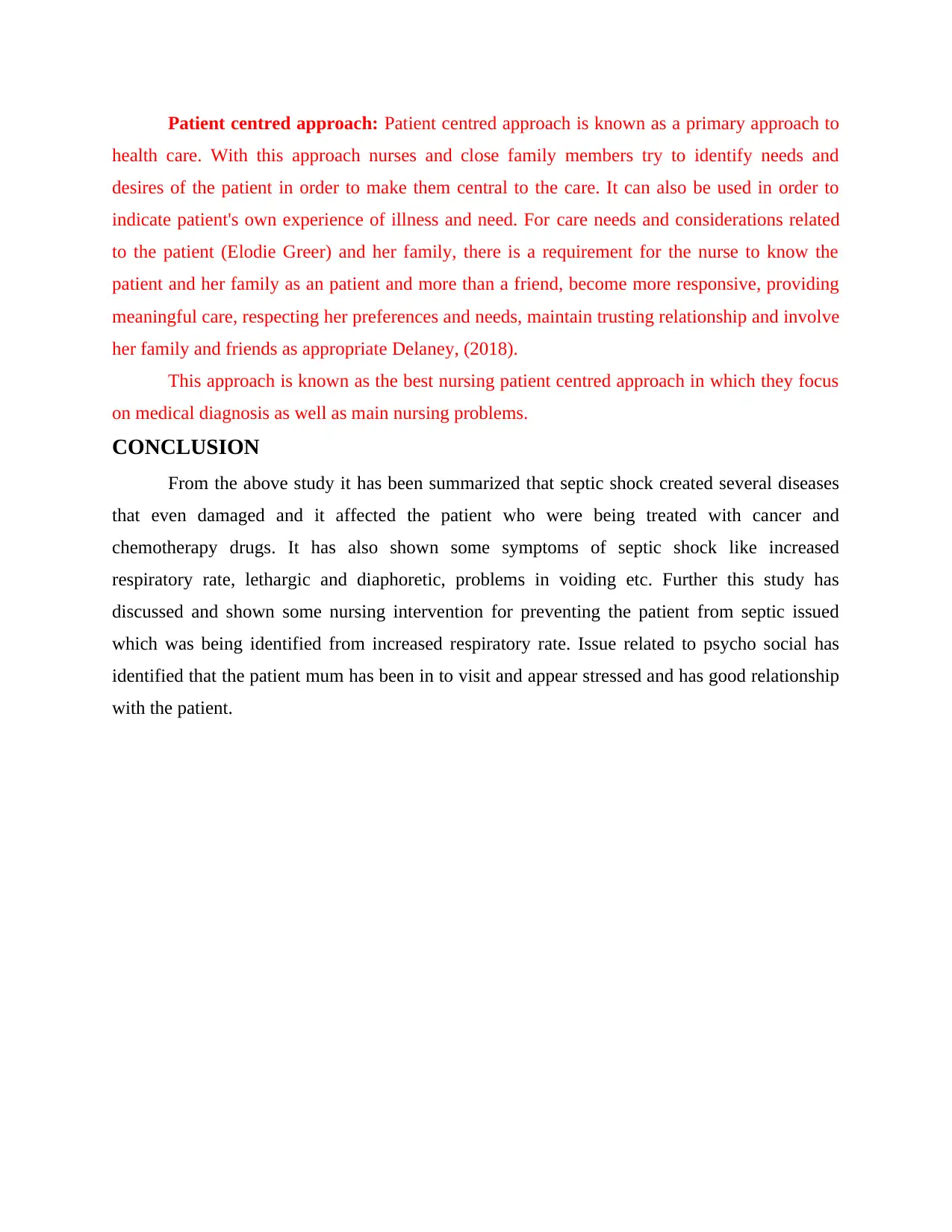
Patient centred approach: Patient centred approach is known as a primary approach to
health care. With this approach nurses and close family members try to identify needs and
desires of the patient in order to make them central to the care. It can also be used in order to
indicate patient's own experience of illness and need. For care needs and considerations related
to the patient (Elodie Greer) and her family, there is a requirement for the nurse to know the
patient and her family as an patient and more than a friend, become more responsive, providing
meaningful care, respecting her preferences and needs, maintain trusting relationship and involve
her family and friends as appropriate Delaney, (2018).
This approach is known as the best nursing patient centred approach in which they focus
on medical diagnosis as well as main nursing problems.
CONCLUSION
From the above study it has been summarized that septic shock created several diseases
that even damaged and it affected the patient who were being treated with cancer and
chemotherapy drugs. It has also shown some symptoms of septic shock like increased
respiratory rate, lethargic and diaphoretic, problems in voiding etc. Further this study has
discussed and shown some nursing intervention for preventing the patient from septic issued
which was being identified from increased respiratory rate. Issue related to psycho social has
identified that the patient mum has been in to visit and appear stressed and has good relationship
with the patient.
health care. With this approach nurses and close family members try to identify needs and
desires of the patient in order to make them central to the care. It can also be used in order to
indicate patient's own experience of illness and need. For care needs and considerations related
to the patient (Elodie Greer) and her family, there is a requirement for the nurse to know the
patient and her family as an patient and more than a friend, become more responsive, providing
meaningful care, respecting her preferences and needs, maintain trusting relationship and involve
her family and friends as appropriate Delaney, (2018).
This approach is known as the best nursing patient centred approach in which they focus
on medical diagnosis as well as main nursing problems.
CONCLUSION
From the above study it has been summarized that septic shock created several diseases
that even damaged and it affected the patient who were being treated with cancer and
chemotherapy drugs. It has also shown some symptoms of septic shock like increased
respiratory rate, lethargic and diaphoretic, problems in voiding etc. Further this study has
discussed and shown some nursing intervention for preventing the patient from septic issued
which was being identified from increased respiratory rate. Issue related to psycho social has
identified that the patient mum has been in to visit and appear stressed and has good relationship
with the patient.
Paraphrase This Document
Need a fresh take? Get an instant paraphrase of this document with our AI Paraphraser

REFERENCES
Books and journals
Arman, A., Demirseren, D. D., & Takmaz, T. (2015). Treatment of ocular rosacea: comparative
study of topical cyclosporine and oral doxycycline. International journal of
ophthalmology. 8(3). 544.
Bhakta, P. & et.al., (2019). Trial of Noninvasive Ventilation with Pressure or Adaptive Support
in Acute Exacerbation of COPD by Sehgal IS et al: Further Considerations. COPD, 1-2.
Cung, T. T. & et.al., (2015). Cyclosporine before PCI in patients with acute myocardial
infarction. New England Journal of Medicine. 373(11). 1021-1031.
Finkelstein, R. A. & et.al., (2018). More Than Skin Deep: Lethargy and Diaphoresis in the
Morning. Pediatric emergency care. 34(12). e246-e250.
Gruenberg, B. U. (2016). The Hoofprints Guide to the Wild Horses of Chincoteage National
Wildlife Refuge (Vol. 2). Quagga Press.
Haque, N., Naqvi, R. M., & Dasgupta, M. (2019). Efficacy of Ondansetron in the Prevention or
Treatment of Post-operative Delirium—a Systematic Review. Canadian Geriatrics
Journal. 22(1). 1-6.
Hotchkiss, R. S. & et.al., (2016). Sepsis and septic shock. Nature reviews Disease primers. 2.
16045.
Mochizuki, K. & et.al., (2017). Importance of respiratory rate for the prediction of clinical
deterioration after emergency department discharge: a single‐center, case–control study.
Acute medicine & surgery. 4(2). 172-178.
Rhodes, A. & et.al., (2017). Surviving sepsis campaign: international guidelines for management
of sepsis and septic shock: 2016. Intensive care medicine. 43(3). 304-377.
Thompson, B. T., Chambers, R. C., & Liu, K. D. (2017). Acute respiratory distress syndrome.
New England Journal of Medicine. 377(6). 562-572.
van Vught, L. A. & et.al., (2016). Incidence, risk factors, and attributable mortality of secondary
infections in the intensive care unit after admission for sepsis. Jama. 315(14). 1469-
1479.
Delaney, L. J. (2018). Patient-centred care as an approach to improving health care in Australia.
Collegian. 25(1). 119-123.
Online
Books and journals
Arman, A., Demirseren, D. D., & Takmaz, T. (2015). Treatment of ocular rosacea: comparative
study of topical cyclosporine and oral doxycycline. International journal of
ophthalmology. 8(3). 544.
Bhakta, P. & et.al., (2019). Trial of Noninvasive Ventilation with Pressure or Adaptive Support
in Acute Exacerbation of COPD by Sehgal IS et al: Further Considerations. COPD, 1-2.
Cung, T. T. & et.al., (2015). Cyclosporine before PCI in patients with acute myocardial
infarction. New England Journal of Medicine. 373(11). 1021-1031.
Finkelstein, R. A. & et.al., (2018). More Than Skin Deep: Lethargy and Diaphoresis in the
Morning. Pediatric emergency care. 34(12). e246-e250.
Gruenberg, B. U. (2016). The Hoofprints Guide to the Wild Horses of Chincoteage National
Wildlife Refuge (Vol. 2). Quagga Press.
Haque, N., Naqvi, R. M., & Dasgupta, M. (2019). Efficacy of Ondansetron in the Prevention or
Treatment of Post-operative Delirium—a Systematic Review. Canadian Geriatrics
Journal. 22(1). 1-6.
Hotchkiss, R. S. & et.al., (2016). Sepsis and septic shock. Nature reviews Disease primers. 2.
16045.
Mochizuki, K. & et.al., (2017). Importance of respiratory rate for the prediction of clinical
deterioration after emergency department discharge: a single‐center, case–control study.
Acute medicine & surgery. 4(2). 172-178.
Rhodes, A. & et.al., (2017). Surviving sepsis campaign: international guidelines for management
of sepsis and septic shock: 2016. Intensive care medicine. 43(3). 304-377.
Thompson, B. T., Chambers, R. C., & Liu, K. D. (2017). Acute respiratory distress syndrome.
New England Journal of Medicine. 377(6). 562-572.
van Vught, L. A. & et.al., (2016). Incidence, risk factors, and attributable mortality of secondary
infections in the intensive care unit after admission for sepsis. Jama. 315(14). 1469-
1479.
Delaney, L. J. (2018). Patient-centred care as an approach to improving health care in Australia.
Collegian. 25(1). 119-123.
Online

Increased respiratory rate. 2019. [Online]. Available through:
<https://www.verywellhealth.com/what-is-a-normal-respiratory-rate-2248932#citation-4>
Sepsis Risk Factors. 2019. [Online]. Available through:
<https://www.emedicinehealth.com/sepsis_blood_infection/article_em.htm#what_are_sepsis_risk_f
actors>
Ways of using ondansetron ODT. 2019. [Online]. Available through:
<https://www.webmd.com/drugs/2/drug-16910-8296/ondansetron-oral/ondansetron-disintegrating-
tablet-oral/details>
Ways of using Cyclosporine. 2019. [Online]. Available through:
<https://www.webmd.com/drugs/2/drug-5645-5108/cyclosporine-oral/cyclosporine-solution-oral/
details>
<https://www.verywellhealth.com/what-is-a-normal-respiratory-rate-2248932#citation-4>
Sepsis Risk Factors. 2019. [Online]. Available through:
<https://www.emedicinehealth.com/sepsis_blood_infection/article_em.htm#what_are_sepsis_risk_f
actors>
Ways of using ondansetron ODT. 2019. [Online]. Available through:
<https://www.webmd.com/drugs/2/drug-16910-8296/ondansetron-oral/ondansetron-disintegrating-
tablet-oral/details>
Ways of using Cyclosporine. 2019. [Online]. Available through:
<https://www.webmd.com/drugs/2/drug-5645-5108/cyclosporine-oral/cyclosporine-solution-oral/
details>
1 out of 9
Related Documents
Your All-in-One AI-Powered Toolkit for Academic Success.
+13062052269
info@desklib.com
Available 24*7 on WhatsApp / Email
![[object Object]](/_next/static/media/star-bottom.7253800d.svg)
Unlock your academic potential
© 2024 | Zucol Services PVT LTD | All rights reserved.





